Aggressive behavior
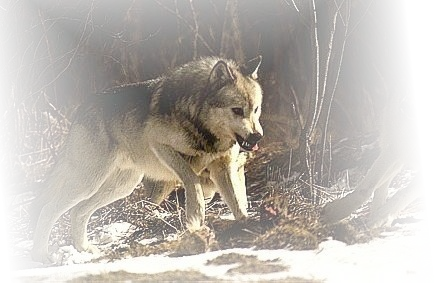
Aggressive behavior is shown almost exclusively to conspecifics: either as an attack against an intruder on the individual's or pack's territory or as a move to dominate another animal. Ears are held erect (or pushed to the side in "airplane ears"), lips puckered and closed or slightly open, eyes wide open, hackles and tail erect, tail held stiffly. The animal carries its body rigidly, with confidence and a stiff-legged walk, and stares at the object of aggression directly, keeping eye contact. Two animals coming together in a ritual (rather than an attack) dominance interaction often make a "T" formation, with the dominant animal pressing its chest into the other's flank. The aggressor may press its chest into the other animal's shoulder or stand up with stiff forelegs braced on the other's shoulder. Mounting is also occasionally seen as a dominance display.
Birth and pregnancy
Preparation for the birth of the pups is a group effort. While the mother begins to prepare one or more dens, the other pack members store food for her to eat, burying it in caches near the den site. The pregnant female may create a den in a cave, a hollow log, or an abandoned den usually of a fox or beaver. Often the female prepares more than one den as a backup site, in case environmental conditions or encroaching animals threaten the pups. A new den may be complete three weeks before the pups are due. Most often a day before the birth, the mother will enter the confinement of the den.
Often the litter size is five or six pups, but can be as little as one or as much as eleven. At birth, pups weigh one pound, cannot hear or see and cannot regulate their own body temperature, depending completely on their mother their first weeks of life. Their mother is the only member of the pack that has contact with them during this time.
All pups have soft, fuzzy brown or black fur at birth with small, droopy ears and blunt muzzles. Within two weeks pups open their eyes and most often begin to walk at this time as well. Between 3-4 weeks they begin to develop real vision. Their eyes are a baby blue, but usually change as they mature. Up to this time, they have fed off their mother's milk. At around three weeks, pups begin to eat semisolid food regurgitated by their mother. They leave the confinement of the den by around 1 month and begin traveling with the pack by 3-5 months. Since IRC wolves don't really travel and stay in the clearing, this would mean the pups would stay close to the den and meet the members for up to 3-5 months, then may start exploring the territory. Pups are independent at about 1 year.
The pack is overly excited when greeting the young pups as they are the pack's future. The pack members welcome the pups with licks and nuzzles, sniffing the new scents. Each wolf now takes the role of Caretaker. Each member provides food, play, and protection for the pups. Adults carry food back for the pups announcing their arrival with little squeaking noises. The pups in turn greet them squeaking, begging, tail wagging then nibble and lick the feeder's muzzle to stimulate regurgitation.
Cubs 3 to 5 months old will begin to learn how to hunt small prey with guidance from the leaders. At 6 to 8 months they may begin hunting medium prey with the Pack. At 9 to 11 months they may hunt big prey with the pack and 12 months to hunt Huge prey. The cubs must be accompanied during their first year. After their first year, they are treated as adult members.
Subordinates vs. Alpha
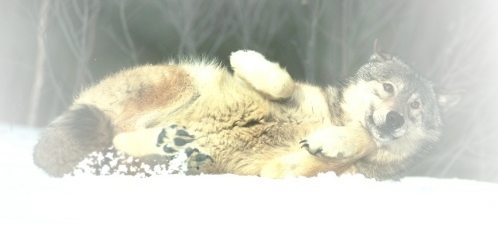
A low ranking wolf will often greet an Alpha wolf by keeping its body low to the ground, with its fur and ears flat. It will then reach up and gently lick or nip the muzzle of the Alpha wolf. Sometimes, all pack members will greet an Alpha in this manner when they return from being absent. This behavior is called active submission; they know their place within the hierarchy and the Alpha does not need to assert they're dominance. Harmony is kept.
Asserting Dominance

If a subordinate wolf tries to challenge the authority of an Alpha wolf, the Alpha will assert their dominance. This can be done in a variety of ways.
-Sometimes, the Alpha will only need to give a stern stare to the rebellious wolf. Wolves do not look at each other directly in the eyes unless they are trying to express their dominance or threaten another wolf.
-The dominant wolf may have to growl and bare its teeth at the rebellious wolf.
-The higher ranking wolf may crouch on the ground as if it were going to pounce on the offender.
-A dominant wolf will also seize the muzzle of a subordinate wolf to assert its authority.
-A dominant animal may also place its front paws across the shoulders of a subordinate animal to assert its authority.
When the subordinate wolf is ready to submit, it will lie on the ground and expose its side and belly to the Alpha. This act is called passive submission, and the alpha wolf will accept it as though it were an apology.
Subtle Dominance and Submission

A dominant wolf will sit up from laying down or stand up from sitting to express their dominance to an approaching wolf in a mild manner. A dominant wolf will also tilt its muzzle up to offer their chin to a submissive wolf. In response, a submissive wolf would lick or nip the higher ranked wolf's chin gently as a show of respect. Dominant wolves hold their tail higher than others when asserting dominance without being overly aggressive..
A submissive wolf will sit or lay down in front of a more dominant wolf to express their submission. Submissive wolves hold their tail lower than other wolves. Example; visitors should be more submissive then all others. Newer members should be more submissive to Older Pack Members. Members should be submissive to Alpha and Beta, Gamma, Warrior, Guardian, Hunter, ect. You get the idea...
Behaviors
We try to think of our pack as close to real wolves as possible. (with the exception of speaking of course). Below are some common behaviors that wolves exhibit. If you don't know much about wolves please use this as a reference while RPing with us.
Submission

A wolf will submit to another wolf when it shows respect or has lost against that wolf in a fight. It isn't quite fear but a little more uniform. The alphas often require submission as a sign of respect and dominance.
The Attack

This wolf is ready to leap and attack. Notice the position of the ears and tail. Often in this situation the wolf and which ever adversary it may be facing will pause and have a short stalemate until one of the animals either attacks or stands down.
Defense
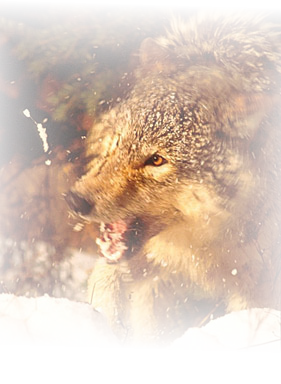
This wolf is taking a defensive stand against whatever enemy it may be fighting. The ears are tucked back, the body braced. This wolf may not want a fight but rather be trying to ward off an enemy. This may be accompanied by growling or snarling.
Wrestling
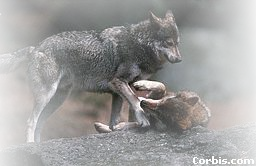
These wolves are wrestling. One wolf has the other pinned by it's shoulder and is showing dominance. Notice his tail is high declaring his victory.
Playfulness
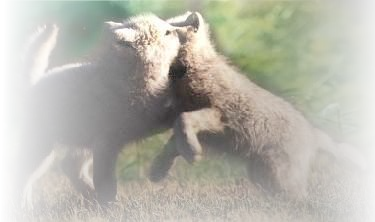
These wolves are ready for some fun. There ears are perky and there tails are right in the middle.
Fear

This wolf is running in fear, most probably from an enemy it could not overcome. Sadly, one of the wolves biggest enemies is humanity.
Playing
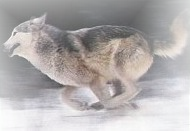
This wolf is running playfully and happily along. It may wrestle or play with another member of it's pack.
Dominance

These wolves show dominance in play. Notice how one wolf shrugs in respect under the shadow of it's superior. The dominant wolf is most likely an alpha and the submissive one a pack member under his command.

 Free Forum Hosting
Free Forum Hosting